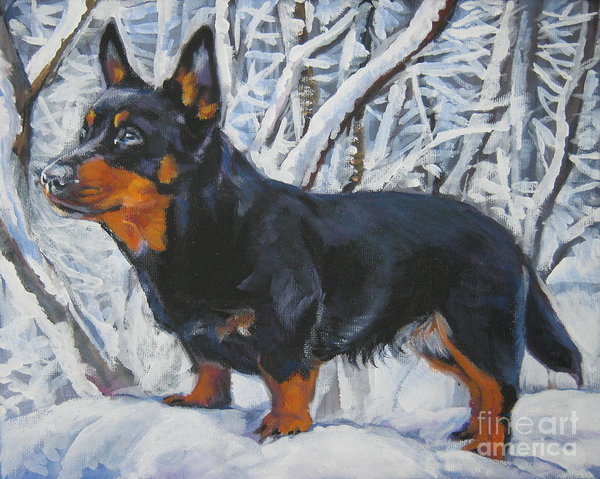
Welcome to a brief history of the Lancashire Heeler, the dog with a smile whose origins are shrouded in time. What is known for certain is that 17th century farmers used the dogs to drive cattle and sheep from Wales to markets in Lancashire in Northwestern England over muddy, rough, and often pitted tracks that passed for roads. Smaller than other cattle driving dogs, Lancashires did their job admirably, thank you very much, by keeping the stock moving by nipping at their heels and ducking out, (earning it another nickname: the “nip and duck dog”), without injuring themselves or the animals they were driving.
Some sources believe the Lancashire Heeler descended from Welsh Corgis bred with local Manchester Terriers. Some think it’s an ancestor of a Welsh Corgi known as the Ormskirk Terrier. Others feel that the breed was a local variety of a Corgi or spitz-type dog kept in one particular district for generations, suggesting that the breed started out as a landrace. Yet another theory is that the LH was the result of breedings between the Drover’s Cur, Norfolk Heeler, Yorkshire, and London Smithfield Collie, all now extinct breeds, but each lending a little bit of itself to the phenotype of the Lancashire Heeler. What seemed to emerge in importance was the dog’s size, and that it be “small enough to fit in a ‘poacher’s pocket.” We may never know the breed’s true origins with certainty, but what we do know is that the Lancashire Heeler may be the smallest drover in the world, and possibly among the rarest with an estimated 5,000 dogs worldwide (only 173 dogs were registered with the Kennel Club in 2006).
As the breed began to disappear in the 1960s, UK affectionados worked to save it; the Lancashire Heeler Club was formed in 1978, a breed standard was written, a registry begun, and shows held where the dogs were judged to the standard. Negotiations with the Kennel Club had been in the works, and in 1981, it granted recognition of the Lancashire Heeler as a rare breed. In 1982, Crufts included the breed in the ‘Not Separately Classified’ classes, and in 1999, Challenge Certificates were allocated for the breed.
Currently, the Lancashire Heeler is listed with the AKC as an FSS breed, and in 2009, it was recognized by the United Kennel Club. In what we see as good news for the breed, it’s said not to have diverged into, “working” and “show” types which we think not only offers opportunities for owners to showcase all the breed’s talents in a variety of venues, but also serves as testament to the breed itself. And if that isn’t persuasive enough, it’s important to note that despite its low numbers, farms in the northwestern part of England are still using these dogs to work with cattle and sheep.

I heard that they were originally bred from corgi and dachshund cross .
In doing our homework on breed history, Marlene, we came across a number of theories, none of which have been proved with certainty, and certainly what you heard can be added to the mix. We posted the theory that seemed to be the one that had the most consensus, but we’re glad you wrote to round on the field of possibilities! Whatever its true ancestry, the Lancashire is a dandie little dog!
I just love them. I have had three over the years. The first was a farm dog who was more effective than the Collie! They have such character and are so cheeky and yet so loyal. My favourite dogs.
Realistically, there is minimal chance that heelers came about through a cross between a corgi and a Manchester Terrier. Manchester Terriers were originally a status symbol for wealthy industrialists, so highly unlikely to be lurking around livestock markets! Corgis were yard-dogs, used to move stock around yards (like heelers: in fact, corgis used to known as ‘Welsh Heelers’ because ‘heeler’ is just a generic name for a type of dog that works by ‘heeling’. It is far more likely that the fore-runners of the Manchester Terrier as we know it today, were dogs similar to the Kelpie or the German Pinscher, that were refined by crossing with true terriers and whippets to create the Manchester Terrier, while others carried the dwarfism gene and were heelers. Migrations from Flanders occurred to Lancashire in Medieval times and again in the 18th century for the flax industry. There were still some communities in Lancashire as late as the 1930s and 1940s who spoke a dialect containing Flemish words and the traditional ‘heeler hotspots’ in Lancashire more of less correspond with these settlements i.e. in the West between Preston, Ormskirk and Southport and over in East Lancashire (as it used to be) around Manchester. National Geographic published an article a few years back that identified DNA ‘types’ consistent in dogs bred for specific functions and Manchester Terriers came out as predominantly pastoral in their DNA – which I think is quite telling.
Thanks for the input, Ada! We love additional information to our posts that help “round out” a reader’s knowledge base. Thank you for sharing this!